Exploring the Enigmatic Tianluokeng Tulou Cluster: A UNESCO World Heritage Site
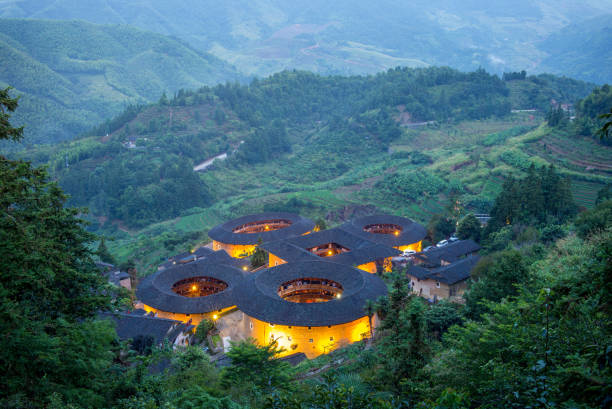
An Essential Guide to Visiting Tianluokeng Tulou Cluster
Nestled in the picturesque hills of Fujian Province, the Tianluokeng Tulou Cluster stands as a testament to the rich cultural heritage and architectural ingenuity of the Hakka people. This UNESCO World Heritage site, often referred to as the “Four Dishes and One Soup,” is a unique ensemble of earthen buildings that boasts a harmonious blend of history, tradition, and breathtaking natural beauty. As you wander through this captivating complex, you’ll encounter round and square structures built with sturdy rammed earth, each telling a story of communal living and resilience against the elements.
The cluster is not just a feast for the eyes; it’s an immersive experience that invites you to connect with the local culture. From the moment you step into the central courtyard of these monumental buildings, you’ll feel a sense of tranquility that echoes the wisdom of generations past. With everything from traditional Hakka cuisine to arts and crafts available for exploration, Tianluokeng Tulou offers a glimpse into a way of life that has flourished for centuries amid dramatic landscapes.
Whether you’re an architecture enthusiast, a history buff, or simply a traveler seeking off-the-beaten-path experiences, the Tianluokeng Tulou Cluster promises an unforgettable journey. Prepare to be mesmerized by its stunning vistas, rich heritage, and the warm hospitality of the local residents who continue to call this extraordinary place home. Embrace the opportunity to step into a world where ancient traditions meet breathtaking scenery, and let the charm of Tianluokeng Tulou weave its magic on your travels.
In This Guide
- An Essential Guide to Visiting Tianluokeng Tulou Cluster
- The Rich History and Legends of Tianluokeng Tulou Cluster
- Main Highlights: What You Absolutely Can’t Miss
- Planning Your Visit: A Practical Guide
- Tickets: Prices, Booking, and Tips
- How to Get There: A Complete Transportation Guide
- Local Cuisine and Accommodation Nearby
- Frequently Asked Questions
- Final Thoughts on Your Trip
The Rich History and Legends of Tianluokeng Tulou Cluster
Nestled in the misty mountains of Fujian Province, the Tianluokeng Tulou Cluster is not just an architectural wonder; it is a living testament to the ingenuity and resilience of the Hakka people. These remarkable earthen structures, built primarily between the late 18th century and the mid-20th century, serve as both homes and fortresses, showcasing a unique blend of practicality and artistry that has withstood the test of time.
The origins of the Tianluokeng Tulou Cluster can be traced back to the migration of the Hakka people, who moved from northern China to the more temperate south. Seeking safety from conflict and natural disasters, they constructed these massive structures using rammed earth, which provided not only strength but also excellent insulation against the elements. The cluster consists of five distinct tulou, each with its own story and significance, reflecting the lifestyle and customs of the Huang family who have inhabited them for generations.
The first of these buildings, the Buyun Building, was erected in 1796 during the Qing Dynasty. Its name, which translates to “Blessings from the Ancestors,” embodies the hopes of the Hakka for prosperity and success for future generations. Following this, the Hechang, Zhenchang, Ruiyun, and Wenchang Buildings were constructed, each contributing to the familial and communal structure that defines the cluster. What’s particularly fascinating is that the entire Tianluokeng complex took about 170 years to complete, with construction practices that highlight the community’s dedication to creating a secure living environment.
Architecturally, the Tianluokeng Tulou Cluster is designed according to the principles of Feng Shui, with its circular and square shapes symbolizing harmony with the five elements: metal, wood, water, fire, and earth. This thoughtful design is evident in the arrangement of the buildings, which often resemble a feast of “four dishes and one soup” when viewed from above. The layout not only facilitates communal living but also embodies the Hakka philosophy of unity and shared responsibility.
Throughout its history, the Tianluokeng Tulou Cluster has faced challenges, from natural disasters to modern encroachments. Yet, it remains a vibrant community where traditions are preserved and shared with visitors. The tulou are still inhabited by local families who operate various shops and eateries, offering a glimpse into the day-to-day lives of the Hakka people. This connection to the past is further enriched by local legends and stories that have been passed down through generations, adding a layer of cultural richness to the experience of visiting this UNESCO World Heritage site.
Visiting the Tianluokeng Tulou Cluster is not merely an architectural tour; it is an invitation to step into a world where history, culture, and community converge. As you wander through the winding paths and under the towering earthen edifices, you will find yourself immersed in the legends and lore that define this remarkable place—a place where the past continues to resonate in the lives of its inhabitants and the hearts of its visitors.
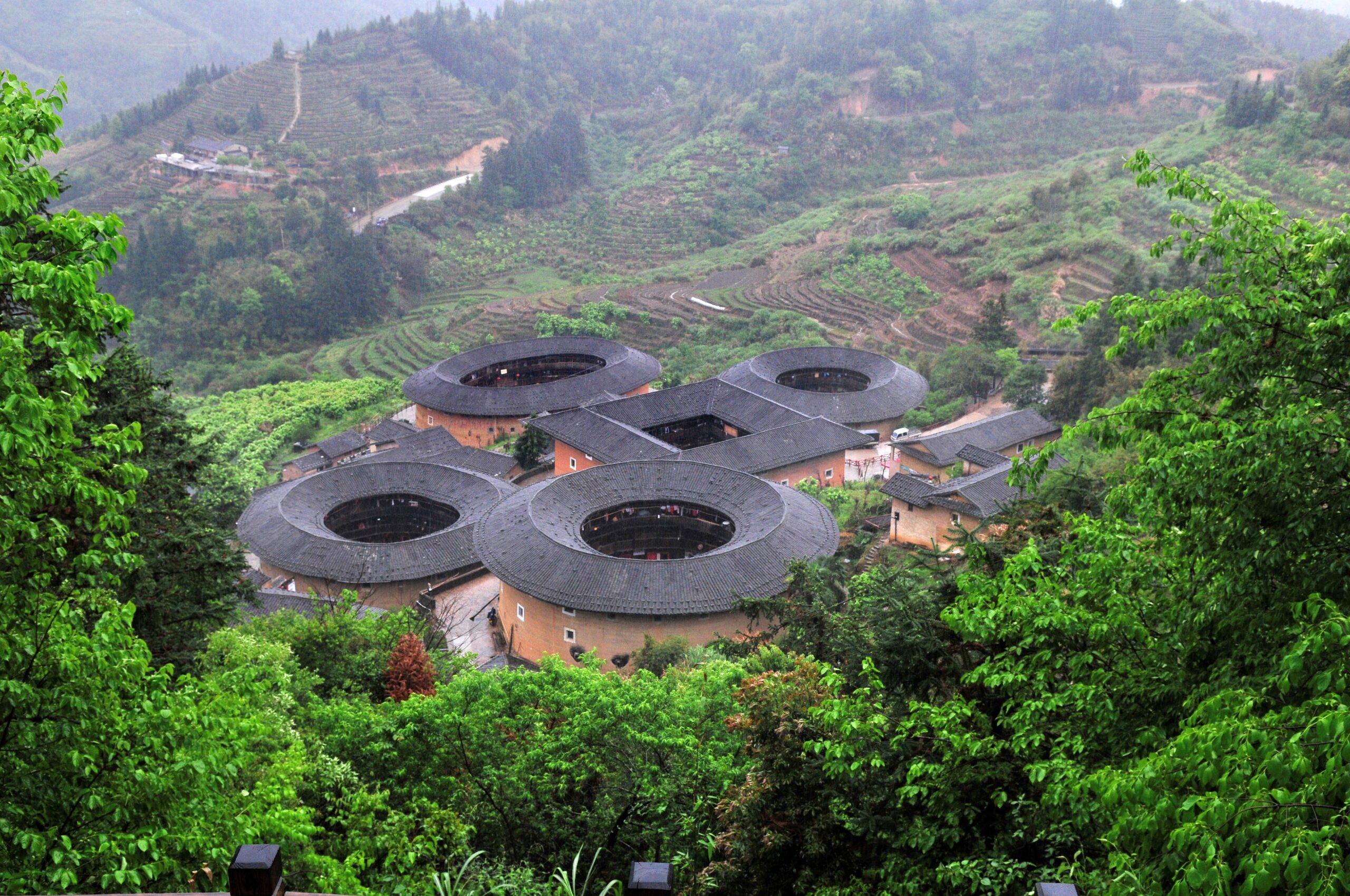
Tianluokeng Tulou Cluster.
Main Highlights: What You Absolutely Can’t Miss
Visiting the Tianluokeng Tulou Cluster is like stepping into a living history book, where ancient architectural techniques and vibrant local culture come together in a stunning landscape. This UNESCO World Heritage site, nestled in the heart of Fujian Province, offers a unique glimpse into the Hakka people’s way of life and their remarkable earthen structures. Here are the main highlights you absolutely can’t miss during your visit:
1. The Tulou Architecture
The Tianluokeng Tulou Cluster consists of five remarkable tulou buildings, each showcasing the ingenuity of Hakka architecture. These structures are designed not only for aesthetics but also for defense against intruders and natural disasters. The most notable among them is the Buyun Building, a square tulou built in 1796, which serves as the centerpiece of the cluster. Don’t miss the chance to explore its three stories, where you’ll find kitchens, barns, and bedrooms, reflecting the communal lifestyle of its residents.
2. Scenic Viewing Platforms
For breathtaking views of the cluster, head to the wooden viewing platform located at the east gate. From here, you can capture the iconic sight of the tulous as they resemble four plates of dishes surrounding a bowl of soup, particularly stunning when viewed from above. Arriving at sunset or dusk offers a magical experience as the tulou are illuminated by lanterns, creating a picturesque scene against the backdrop of the setting sun.
3. Cultural Immersion
The Tianluokeng Tulou Cluster is not just an architectural marvel; it’s a vibrant community still inhabited by local families. Engage with residents who run small shops offering traditional crafts and local delicacies. This is an excellent opportunity to taste the famous “Four Dishes and One Soup,” a signature Hakka meal that showcases the region’s culinary delights. Participating in a cooking class or local food tour can further enrich your cultural experience.
4. Natural Surroundings
Set against a backdrop of lush mountains and rolling hills, the Tianluokeng Tulou Cluster is surrounded by nature’s beauty. Take some time to explore hiking trails that wind through the scenic landscape. The uneven terrain adds to the adventure, and the fresh air and stunning vistas make it a perfect spot for nature lovers.
5. Nighttime Magic
If your schedule allows, consider visiting the tulou at night. The sight of the buildings illuminated by lanterns creates an enchanting atmosphere, offering a dramatically different perspective from daytime visits. Strolling through the cluster under the stars can be a memorable experience, providing a sense of tranquility and connection to the past.
6. Nearby Attractions
While in the area, don’t miss the chance to explore nearby attractions such as the Yuchang Tower, the oldest circular tulou, which dates back to the Yuan Dynasty and is famous for its enduring structure. Additionally, the quaint Taxia Village offers a serene hiking experience surrounded by nature, while Yunshuiyao Ancient Town captivates visitors with its blend of history and stunning landscapes.
Conclusion
The Tianluokeng Tulou Cluster is a destination that beautifully encapsulates the rich history, culture, and stunning architecture of the Hakka people. From the intricate designs of the tulou to the vibrant local life, every aspect of this site invites exploration and appreciation. Make sure to include these highlights in your itinerary for an unforgettable experience in Fujian Province!
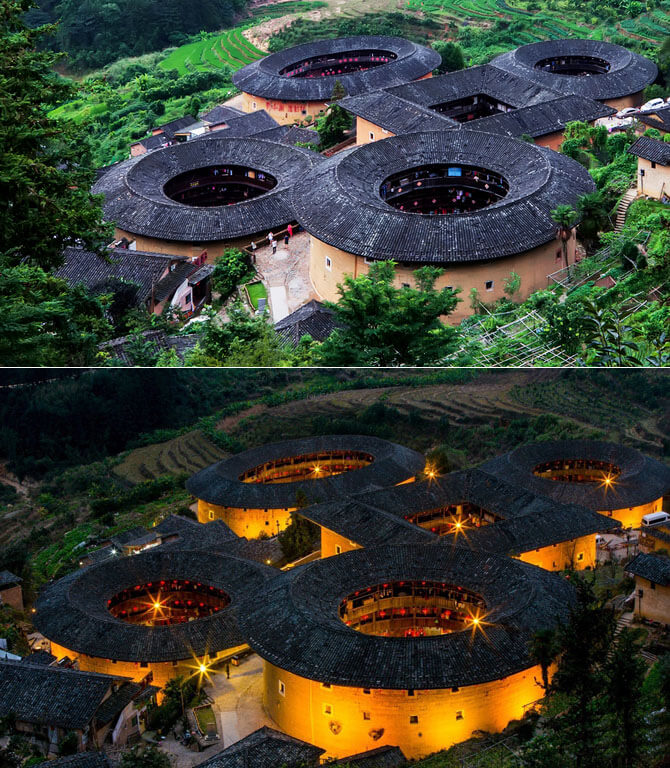
Tianluokeng Tulou Cluster.
Planning Your Visit: A Practical Guide
Visiting the Tianluokeng Tulou Cluster is like stepping back in time to a unique architectural heritage that showcases the ingenuity of the Hakka people. Nestled in the stunning landscapes of Fujian Province, this extraordinary site offers a blend of cultural history and scenic beauty that will leave you enchanted. Here’s a comprehensive guide to help you plan your visit.
Getting There
Location
The Tianluokeng Tulou Cluster is located in Tianluokeng Village, Shuyang Town, Nanjing County, Fujian Province, China.
Transportation Options
– By Car: The most convenient way to reach the cluster is by hiring a local driver or renting a car for a self-guided road trip. This allows you the flexibility to explore the area at your own pace.
– Public Transport: If you prefer public transport, take the Nanjing No. 6 bus to the Nanjing Tulou Reception Center. From there, a tourist bus will take you directly to the Tianluokeng Tulou Cluster.
Tickets and Opening Hours
- Admission Fee: Entry to the Tianluokeng Tulou Cluster costs 90 yuan per person. Additionally, public transportation to the cluster incurs a fare of about 15 yuan per person.
- Opening Hours: The site is open all year round, and you can visit at any time, day or night.
What to Wear
Given the pebbled pathways throughout the cluster, it’s advisable to wear comfortable flat shoes or sneakers to prevent slips and ensure ease of movement as you explore the area.
Best Time to Visit
While the Tianluokeng Tulou Cluster is beautiful year-round, visiting during the early morning or late afternoon can enhance your experience. The soft lighting during these times adds to the picturesque views, and if you’re adventurous, consider a night visit to see the lanterns illuminating the tulou, creating a magical atmosphere.
What to See
The Tianluokeng Tulou Cluster features five remarkable buildings, each with its own story and architectural style. Notable structures include:
- Buyun Building: The central square building, constructed in 1796, symbolizes blessings for success and prosperity.
- Hechang Building, Zhenchang Building, Ruiyun Building, and Wenchang Building: Each of these builds has a unique character and showcases the traditional Hakka communal way of living.
From the nearby viewing platform, you can admire the cluster’s unique layout resembling “four dishes and one soup,” a sight that is particularly stunning when viewed from above.
Nearby Attractions
While in the area, consider exploring these nearby sites:
- Yuchang Tower: The oldest and largest circular tulou, dating back 700 years, offering insights into the region’s rich history.
- Taxia Village: A tranquil Hakka village ideal for hiking, surrounded by breathtaking natural scenery.
- Yunshuiyao Ancient Town: A UNESCO World Heritage site, known for its captivating landscapes and cultural significance.
Tips for a Memorable Visit
- Photographic Opportunities: Don’t forget your camera! The architectural beauty and surrounding landscapes provide countless photo opportunities.
- Guided Tours: For a deeper understanding of the cultural significance and history of the tulou, consider joining a guided tour led by a local expert.
- Local Cuisine: Take advantage of the small eateries run by local residents. Try the famous “Four Dishes and One Soup,” a traditional Hakka meal that provides a genuine taste of the region.
Conclusion
With its breathtaking architecture, rich cultural heritage, and stunning natural surroundings, the Tianluokeng Tulou Cluster is a must-visit destination for any traveler seeking an authentic experience in China. Plan your visit, immerse yourself in the history of the Hakka people, and enjoy the warmth of local hospitality. Whether you choose to explore on your own or with a guided tour, this UNESCO World Heritage site promises to be an unforgettable part of your travels.
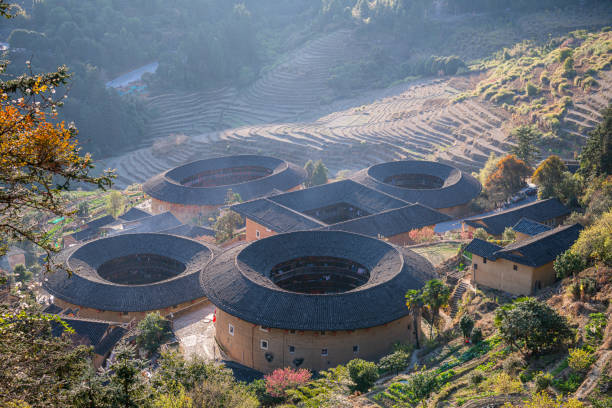
Tianluokeng Tulou Cluster.
Tickets: Prices, Booking, and Tips
When planning your visit to the breathtaking Tianluokeng Tulou Cluster, it’s essential to be informed about ticketing and transportation options to ensure a smooth experience.
Ticket Information
- Admission Price: The ticket for accessing the Tianluokeng Tulou Cluster is 90 yuan per person. This fee contributes to the maintenance and preservation of this unique cultural heritage site.
- Transportation Fare: If you’re using public transportation, a bus fare will be an additional 15 yuan per person to reach the cluster from the Nanjing Tulou Reception Center.
Opening Hours
- The Tianluokeng Tulou Cluster is open 24 hours a day, all year round. This flexibility allows you to explore the area at your own pace, whether you prefer the tranquility of early morning or the enchanting atmosphere of the illuminated tulou at night.
Tips for Booking and Visiting
-
Advance Planning: While tickets can generally be purchased on-site, consider booking through a local tour operator for a hassle-free experience, especially during peak travel seasons.
-
Transportation Options: Hiring a local driver is highly recommended for convenience and time-saving, particularly if you’re exploring other nearby attractions. Alternatively, take the Nanjing No. 6 bus to the reception center and switch to a tourist bus to reach the tulou cluster.
-
What to Wear: The paths within the Tianluokeng area are paved with pebbles, which can be slippery. Comfortable flat shoes or sneakers are advisable to navigate the terrain safely.
-
Best Viewing Spots: Don’t miss the wooden platform at the east gate. This is the ideal location for panoramic views of the tulou cluster, particularly stunning at night when lanterns illuminate the surroundings.
-
Enjoy Local Cuisine: The area is not only about architecture; indulge in local dishes offered by residents who operate small eateries and shops within the cluster.
By keeping these details in mind, you can enhance your visit to the Tianluokeng Tulou Cluster, immersing yourself in its rich history and stunning architecture. Safe travels!
How to Get There: A Complete Transportation Guide
Reaching the breathtaking Tianluokeng Tulou Cluster, a remarkable example of Hakka architecture nestled in the heart of Fujian Province, is a journey worth undertaking. Here’s how to navigate your way to this UNESCO World Heritage site.
Starting Your Journey
From Xiamen
Xiamen serves as an excellent launch point for your adventure to Tianluokeng. The distance from Xiamen to the Tulou cluster is approximately 140 kilometers, and there are several convenient options to consider:
-
Private Car Hire: The most flexible and comfortable way to get to Tianluokeng is by hiring a local driver. This option allows you to stop along the way, admire the scenic landscapes, and travel at your own pace. Many drivers can be arranged through local travel agencies or hotel concierges.
-
Bus: For budget travelers, taking a bus is a viable option. From Xiamen, head to the Xiamen North Station and board a bus to Nanjing County. Once in Nanjing, transfer to the Nanjing No. 6 bus, which will take you to the Nanjing Tulou Reception Center. From there, catch a tourist bus that will take you directly to the Tianluokeng Tulou Cluster.
-
Tour Packages: Consider booking a guided tour that includes transportation. Many tour operators in Xiamen offer packages that cover the Tianluokeng Tulou Cluster along with other nearby attractions.
From Other Major Cities
If you are traveling from other major cities in China, the following routes can be beneficial:
-
From Fuzhou: Fuzhou is about 250 kilometers away from the Tulou cluster. You can take a high-speed train to Nanjing, followed by the local bus services to reach your destination.
-
From Hangzhou or Shanghai: Take a flight to Xiamen, then proceed with the options listed above.
Getting Around the Tianluokeng Area
Once you arrive at the Tianluokeng Tulou Cluster, you’ll find that the area is compact and walkable, but here are some tips for getting around:
-
Foot Traffic: The cluster is best explored on foot. Be sure to wear comfortable and sturdy shoes, as the paths can be uneven and are paved with pebbles.
-
Local Transport: If you wish to explore further afield, consider hiring a local taxi or using ride-sharing apps available in the area.
Parking Information
If you are driving, there are parking facilities available near the viewing platform of the Tianluokeng Tulou Cluster. However, during peak travel times, such as the Chinese New Year, parking may be limited, so plan accordingly.
Final Thoughts
Visiting the Tianluokeng Tulou Cluster offers a glimpse into the rich cultural heritage of the Hakka people and the stunning architectural marvels they created. Whether you opt for a private driver, public transport, or a guided tour, getting to this extraordinary site is straightforward and rewarding. Don’t forget to bring your camera to capture the unique beauty of these earthen structures, often referred to as “Four Dishes and One Soup” due to their unique arrangement. Happy travels!
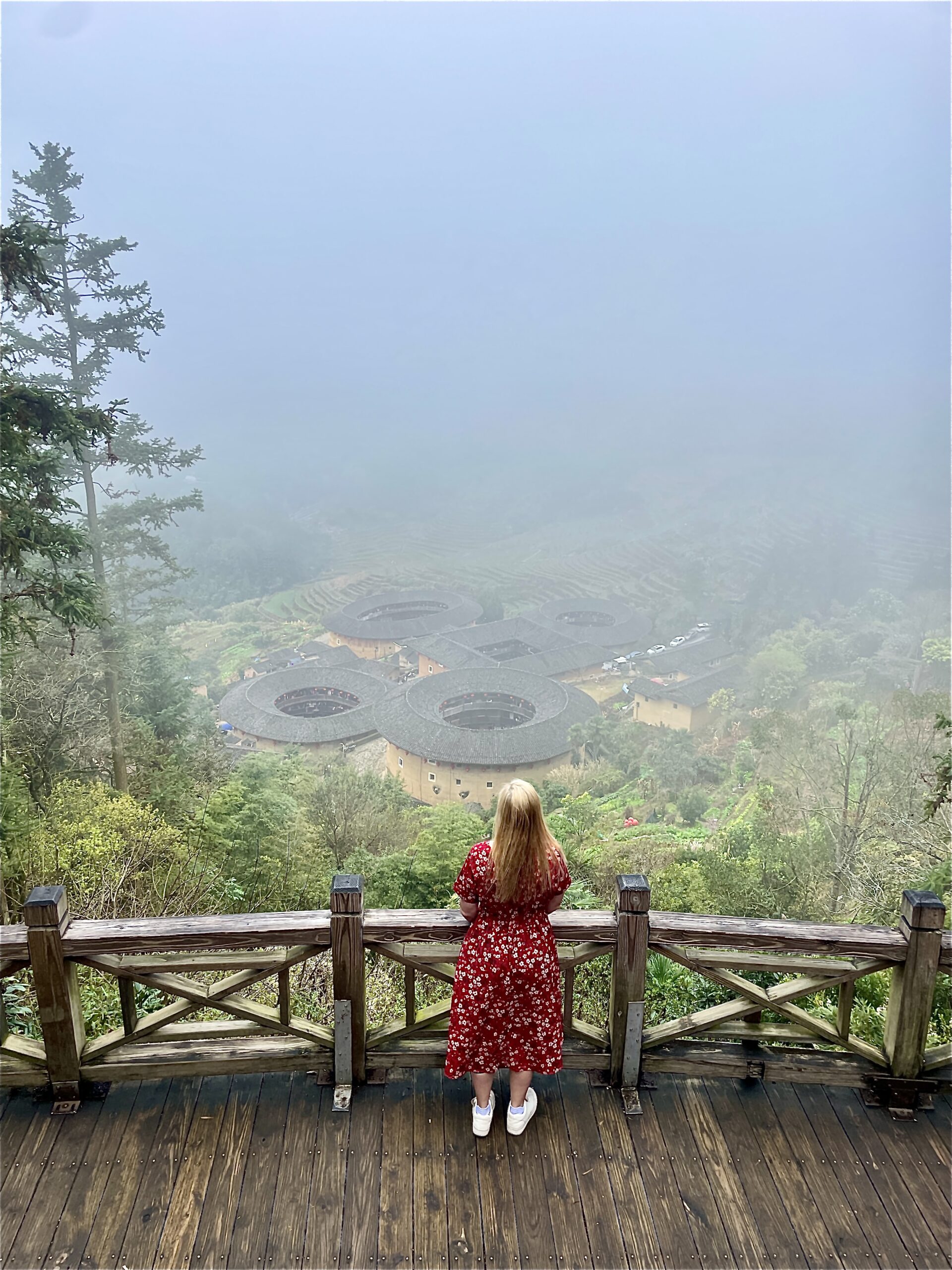
Tianluokeng Tulou Cluster.
Local Cuisine and Accommodation Nearby
Nestled in the enchanting landscape of the Tianluokeng Tulou Cluster, you’ll find a delightful array of local cuisine and charming accommodations that will enhance your visit to this UNESCO World Heritage site.
Savoring Local Flavors
The culinary scene around the Tianluokeng Tulou Cluster is a true reflection of Fujian’s rich heritage. One must-try dish is the renowned “Four Dishes and One Soup,” a traditional Hakka meal that features an assortment of dishes such as stir-fried vegetables, braised meats, and savory tofu, all served alongside a comforting soup. Local eateries, often run by the residents themselves, provide an authentic dining experience where you can indulge in these flavors.
In addition to the Hakka specialties, you’ll also find fresh local ingredients transformed into delicious dishes at small restaurants in nearby Taxia Village. Here, the tranquil surroundings make it an excellent spot to enjoy a meal while soaking in the beauty of the scenery. Be sure to try the Bamboo Rice, a local delicacy cooked in bamboo tubes, which adds a unique flavor to the rice.
Cozy Accommodations
For those looking to immerse themselves in the local culture, there are several charming accommodations nearby. Hakka Tulou Guesthouses offer a unique opportunity to stay within a tulou itself. These guesthouses are often family-run, providing a warm atmosphere and a chance to experience the Hakka way of life firsthand.
Another excellent option is the Yunshuiyao Ancient Town, just a short drive away, where a variety of guesthouses and boutique hotels can be found. Many of these places boast stunning views of the tulou and the surrounding mountains, making for a picturesque retreat after a day of exploration.
Tips for Your Stay
- Book in Advance: Especially during peak seasons, it’s wise to reserve your accommodation ahead of time to secure the best spots.
- Local Dining: Don’t hesitate to ask your hosts for recommendations on the best local eateries. They often know hidden gems that are not widely advertised.
- Cultural Experiences: Some guesthouses offer cooking classes or guided tours of the tulou, providing an enriching experience during your stay.
Whether you’re indulging in the delicious local cuisine or unwinding in a cozy guesthouse, your time at the Tianluokeng Tulou Cluster promises to be both memorable and enriching.
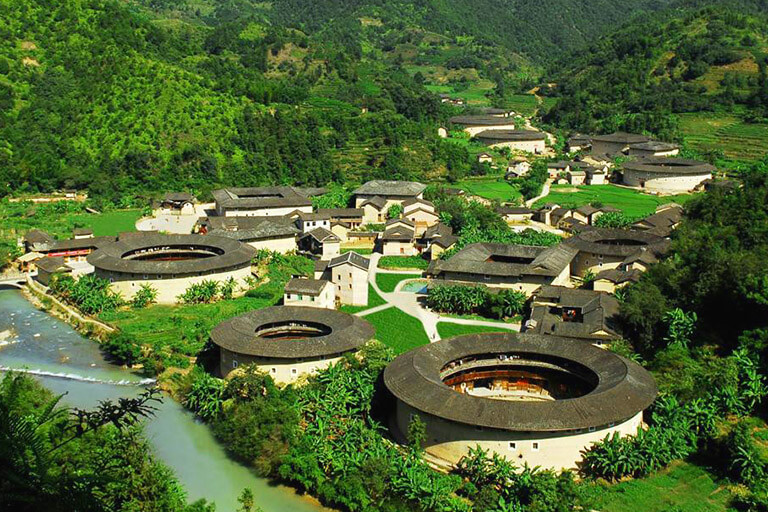
Tianluokeng Tulou Cluster.
Frequently Asked Questions
-
What are the opening hours for the Tianluokeng Tulou Cluster?
The Tianluokeng Tulou Cluster is open 24 hours a day, all year round. This allows you to explore the unique architecture and stunning scenery at your convenience, whether you prefer a daytime visit or a magical night experience illuminated by lanterns. -
How do I get to Tianluokeng Tulou Cluster?
The most efficient way to reach the cluster is by hiring a local driver or joining a tour. Alternatively, you can take the Nanjing No. 6 bus to the Nanjing Tulou Reception Center, then transfer to a tourist bus that will take you directly to the Tianluokeng Tulou Cluster. -
What is the ticket price for visiting the cluster?
The entrance fee to the Tianluokeng Tulou Cluster is 90 yuan per person. Additionally, public transportation to the site costs around 15 yuan per person. -
What should I wear when visiting the Tianluokeng Tulou Cluster?
It is advisable to wear flat shoes or sneakers due to the pebbled pathways, which can be slippery. Comfortable footwear will enhance your experience as you explore the cluster and its surroundings. -
Are there any facilities or services available for visitors?
Yes, the Tianluokeng Tulou Cluster has various local shops and eateries run by residents. Here, you can enjoy authentic Hakka cuisine and purchase handmade crafts. Additionally, there are viewing platforms that provide stunning panoramic views of the cluster. -
Is the Tianluokeng Tulou Cluster suitable for families with children?
Absolutely! The area is family-friendly, with plenty of space for children to explore and learn about the unique Hakka culture and architecture. Just ensure to supervise younger children on the uneven pathways. -
What is the best time to visit Tianluokeng Tulou Cluster?
Visiting in the morning or late afternoon can be particularly rewarding, as the light enhances the beauty of the earth buildings. If you want a unique experience, consider visiting at night to see the lanterns lit up, creating a magical atmosphere. -
What other attractions are nearby?
In addition to the Tianluokeng Tulou Cluster, you can explore nearby attractions such as Yuchang Tower, a historic round tulou, and Taxia Village, a serene Hakka village perfect for hiking. Yunshuiyao Ancient Town is also nearby, known for its stunning scenery and cultural significance.
Final Thoughts on Your Trip
As you reflect on your journey through the enchanting Tianluokeng Tulou Cluster, let the memories of its towering earthen structures and the warm hospitality of the Hakka people linger in your heart. This unique architectural marvel, with its rich tapestry of history, culture, and stunning natural surroundings, offers a glimpse into a way of life that is both ancient and vibrant.
Wander through the winding paths lined with lush greenery, savor the local delicacies that embody the essence of “Four Dishes and One Soup,” and immerse yourself in the stories that each tulou whispers. Whether you’re an architecture enthusiast, a nature lover, or simply seeking to experience the authentic spirit of rural China, Tianluokeng has something special for everyone.
Don’t forget to capture the breathtaking views from the viewing platform, especially at dusk when the lanterns cast a magical glow over the cluster, creating an unforgettable atmosphere. As you prepare to leave this extraordinary destination, take a piece of its beauty with you—a reminder of the resilience and ingenuity of the Hakka people, and the timeless charm of Fujian’s landscapes.
So, carry the spirit of Tianluokeng with you, share your experiences, and inspire others to explore this hidden gem. Your adventure may end here, but the stories and connections you’ve forged will accompany you long after you’ve departed. Safe travels!